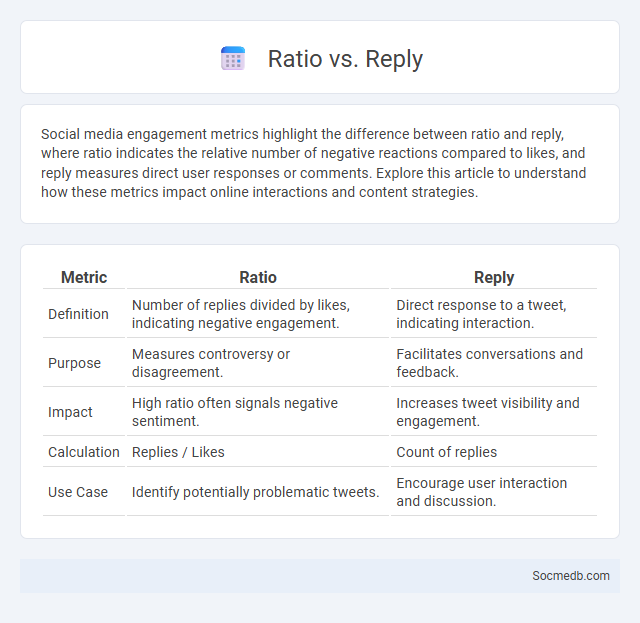
Photo illustration: Ratio vs Reply
Social media engagement metrics highlight the difference between ratio and reply, where ratio indicates the relative number of negative reactions compared to likes, and reply measures direct user responses or comments. Explore this article to understand how these metrics impact online interactions and content strategies.
Table of Comparison
| Metric | Ratio | Reply |
|---|---|---|
| Definition | Number of replies divided by likes, indicating negative engagement. | Direct response to a tweet, indicating interaction. |
| Purpose | Measures controversy or disagreement. | Facilitates conversations and feedback. |
| Impact | High ratio often signals negative sentiment. | Increases tweet visibility and engagement. |
| Calculation | Replies / Likes | Count of replies |
| Use Case | Identify potentially problematic tweets. | Encourage user interaction and discussion. |
Understanding the Concepts: Ratio, Reply, and Re-Ratio
In social media, understanding the concepts of Ratio, Reply, and Re-Ratio is crucial for interpreting engagement and sentiment on posts. A Ratio occurs when replies significantly outnumber likes or retweets, indicating potential controversy or disagreement with Your content. Reply refers to the direct responses to a post, while Re-Ratio describes a second layer of engagement where replies to replies gain more attention than the original, often amplifying discussions or conflicts.
The Origins of "Ratio" in Online Discourse
The term "ratio" in online discourse originated on Twitter as a way to measure unfavorable public reactions when replies outnumber likes and retweets, signaling that a post is widely criticized or disagreed with. Your understanding of social media dynamics improves when you recognize that a high reply-to-like ratio often reflects community disapproval rather than engagement. This terminology has since expanded across platforms, becoming a key metric in digital communication and social media analysis.
What Is a "Reply" and How Does It Differ?
A "reply" on social media is a direct response to a specific post or comment, allowing users to engage in targeted conversations within a thread. Unlike general comments, replies are contextually linked to original messages, facilitating clearer dialogue and interaction. Your ability to reply enables more personalized communication, helping to build connections and maintain the flow of discussion on platforms like Twitter, Facebook, and Instagram.
The Emergence of the "Re-Ratio" Phenomenon
The emergence of the "Re-Ratio" phenomenon on social media highlights a growing trend where users respond to posts by significantly outnumbering likes with quote retweets or replies, signaling disagreement or criticism. This behavior reflects a shift in online engagement, where Your influence is measured not only by positive interactions but also by the volume and nature of foundational pushback. Understanding the dynamics of the "Re-Ratio" can help you better navigate digital conversations and manage your social media presence effectively.
Semantic Analysis: Ratio vs Reply vs Re-Ratio
Semantic analysis of social media interactions differentiates between Ratio, Reply, and Re-Ratio to gauge content impact and engagement quality. A Ratio indicates a high number of replies relative to likes or retweets, often signaling controversy or disagreement, while a Reply represents direct user responses that can provide sentiment context. Your strategic monitoring of these metrics enables deeper insights into audience reaction and community dynamics.
Impacts on Online Engagement and Conversation Flow
Social media platforms significantly influence online engagement by facilitating instant interactions and broadening audience reach, which enhances real-time conversation flow. Your ability to connect with diverse communities online fosters dynamic discussions and encourages the exchange of ideas, driving deeper involvement. This constant connectivity also shapes user behavior, prompting more frequent sharing, commenting, and collaborative content creation.
Social Media Platforms Where These Terms Thrive
Social media platforms like Instagram, Twitter, TikTok, and Facebook are hotspots where trending terms and hashtags gain significant traction and visibility. Algorithms on these platforms prioritize content that resonates with users, enabling Your posts to reach a broader audience swiftly. Engaging consistently on these platforms can help you tap into emerging conversations and enhance your social media presence effectively.
Strategies for Responding: To Reply, Ratio, or Re-Ratio
Effective social media strategies for responding include timely replies to engage audiences and build community trust. Monitoring the reply ratio helps assess interaction quality and identify influencers or detractors. Utilizing re-ratio tactics can amplify important messages while managing controversial content to control brand reputation.
Case Studies: Notable Ratios and Re-Ratios in Internet History
Notable case studies in social media highlight key ratios such as the 1% rule, illustrating how roughly 1% of users create the majority of content while 90% remain passive observers, shaping engagement dynamics. Re-ratios like the influence ratio, measuring the multiplier effect of shares and retweets, demonstrate how viral content can exponentially amplify reach beyond original audiences. Understanding these patterns helps optimize your social media strategy for higher interaction and sustained user growth.
The Future of Digital Interactions: Trends in Ratio Culture
Ratio culture on social media represents a significant shift in digital interactions, emphasizing quick, quantifiable feedback through likes, comments, and retweets to gauge content popularity and sentiment. Emerging trends show increasing user awareness and strategic engagement patterns, where content creators optimize posts for higher ratio scores to boost visibility and influence. This evolution highlights the growing importance of social metrics in shaping online communication behaviors and digital identity formation.
 socmedb.com
socmedb.com